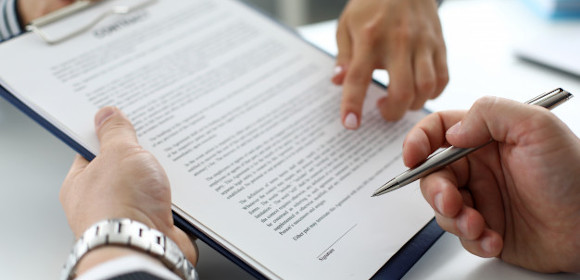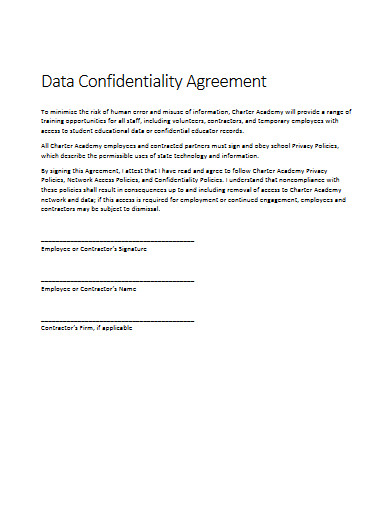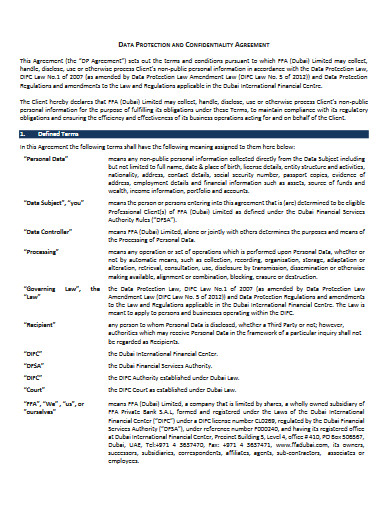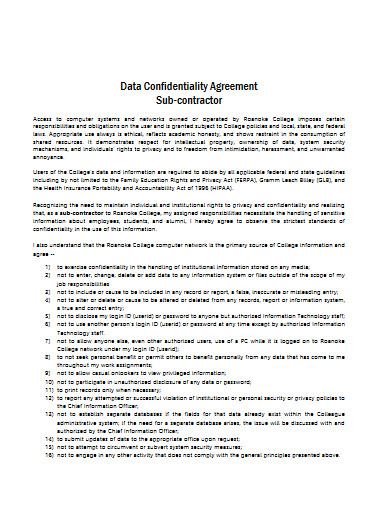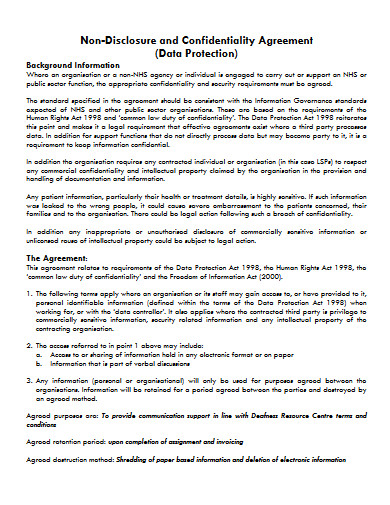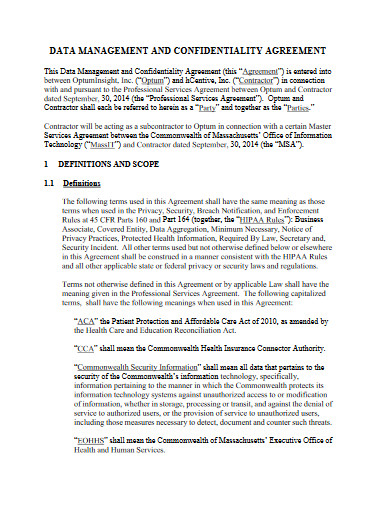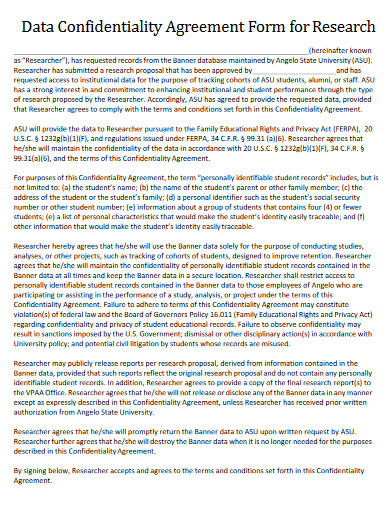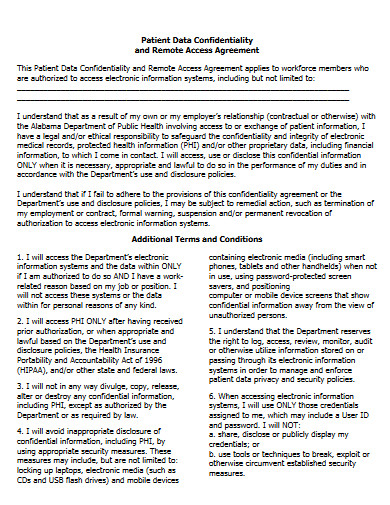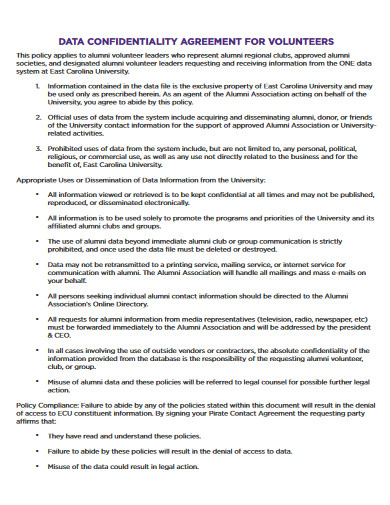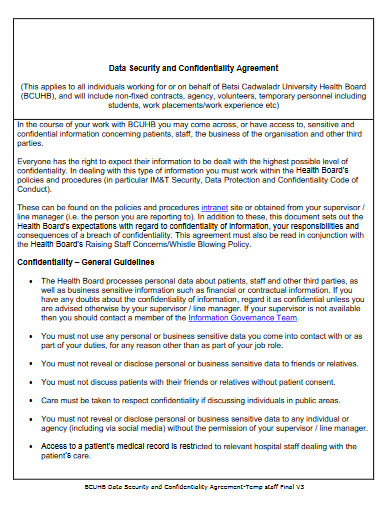10+ Data Confidentiality Agreement Examples to Download
Businesses have secrets, and if they’re competitive enough, they won’t show this personal information off to the public. These confidential details could be about research, financial undertakings, legal disputes, or some misdemeanor, which can have a great effect on customers, potential investors, and competitors. As part of most data processing in a workplace, the documents that hold sensitive facts are put under non-disclosure status by the contractors’ staff or employees and consultants. The data privacy will then be acknowledged, documented, and agreed upon by stakeholders and witnesses through a data confidentiality agreement. Learn more about such an agreement with the help of our article and examples below!
10+ Data Confidentiality Agreement Examples
1. Data Processing Services Confidentiality Agreement Template
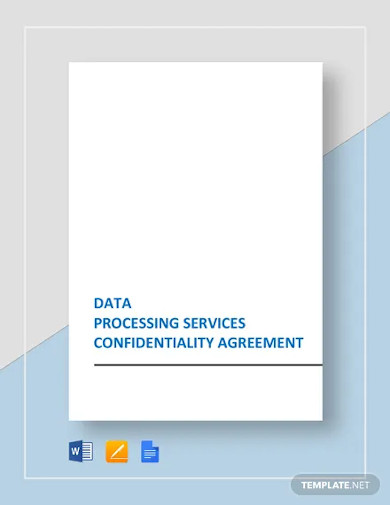
2. Data Confidentiality Agreement
3. Data Protection and Confidentiality Agreement
4. Sub Contractor Data Confidentiality Agreement
5. Data Protection Confidentiality Agreement
6. Data Management and Confidentiality Agreement
7. Student Data Confidentiality Agreement
8. Data Confidentiality Agreement Form for Research
9. Patient Data Confidentiality Agreement
10. Data Confidentiality Agreement for Volunteers
11. Data Security and Confidentiality Agreement
What Is a Data Confidentiality Agreement?
A data confidentiality agreement or non-disclosure agreement is a legal document that binds a company and an individual or another organization to protect sensitive information. The Balance Small Business’s Jean Murray stated in his October 2019 article that there are four situations when such an agreement should be produced. The first situation is during a recruitment process where you have to necessarily expose the job applicants or contractors to some private information. Such anagreement should also be produced whenever you are selling, and you want to prevent clients from disclosing classified information. Another situation is when you’re presenting business plans, marketing plans, or other documents alike that contain restricted details to potential investors. Lastly, it has to be produced and agreed upon by your workforce whenever they are working on a proprietary product or tool or concept.
Types of Confidential Information
An organization holds not just one but tons of information in its data inventory. Because of this, many people would find it hard to distinguish which data is confidential and which is not. To help you classify the pieces of information better, here are the different types of details that are considered confidential.
– Name, birthdate, age, sex, and residential address
– Contact information
– Banking information
– Medical records
– Personal care matters
– Service records and file progress notes
– Personal goals
– Assessments and reports
– Guardianship orders
– Incoming and outgoing communication
How to Prepare a Data Confidentiality Agreement
Since the safety of company information is at stake, there’s a need for you to cover all necessary areas when preparing a data confidentiality agreement. But it doesn’t stop there. You also have to ensure that each of its sections is put in the right order. Doing so makes it easier for the readers to logically comprehend its context. Below, we’ve provided you with an outline to make sure you get everything covered in an orderly manner.
1. Set Effectivity Date
It is very crucial in technical writing to indicate the effectivity dates in business-related documents like request letters, notices, memos, agreements, and others. This lets the concerned audience know whether they have enough time to prepare themselves for any implementation or not. Therefore, you must begin your data confidentiality agreement by setting the completion date of when the implementation will take into effect.
2. Name Involved Parties
Right after you’ve set the effectivity date, the next step that you have to take is to name who the involved parties are. As for a data confidentiality agreement, the parties are categorized as the disclosing party and receiving party. Naming the participants is an important factor to look into as per standard dispute resolution policy.
3. State the Purpose of Agreement
The purpose of an agreement has to be known not just by the participants but also by the other authorized audiences. Hence, it has to be stated in your document clearly. For example, the disclosing party has to provide its company’s market research plan to potential investors as an act of appealing for their interests.
4. Describe the Subject of the Agreement
Since the agreement is all confidential data, describe what it is thoroughly. The different types of sensitive information were enumerated above for your reference. Take note that plans, research findings, and evaluations are some of the other kinds of confidential information that can also be considered as a subject of an agreement.
5. Enumerate Exclusions
Just like any agreement, data confidentiality also has exclusions. Here are some excellent examples:
1. The data is already owned by the receiving party even before the agreement.
2. The data was already knowledgeable about the disclosed information through another source.
3. The disclosed data is already known to the public.
6. Define the Conditions
Once the exclusions have been enumerated, define each item that the receiving party has to agree with. This might include the non-disclosure of information without the authorization of the disclosing party, non-disclosure of information with parties other than the participants, and the usage of the private details for business activities only.
7. Add Termination Clause
Termination clause details the appropriate procedures whenever a breach in the agreement takes place. The most common resolution for this type of agreement is the injunction. It’s when the court orders the breaching participant to discontinue further disclosures of sensitive information.
FAQs
How can we secure confidential data?
According to the University of Delaware, any confidential data can be secured by observing the following:
– Encrypting them on the database
– Managing accessibility
– Physically sealing devices and printed documents
– Proper disposal of data, devices, printed records
– Managing data acquisition
– Managing data usage
– Managing devices
What are the different network attacks on data confidentiality?
There are eight types of network attacks on data confidentiality, according to OmniSecu. They include the following:
– Packet Capturing
– Password Attacks
– Port Scanning and Ping Sweeps
– Dumpster Diving
– Wiretapping
– Keylogger
– Phishing and Pharming
– Social Engineering
What is an active attack?
An active attack is a network attack where the hackers alter the data’s details, which is typically done to damage their targets’ reputations.
Data in all forms can either make us or break us. To avoid the latter, we put most of them into confidentiality. However, there are some business undertakings that require them. Fortunately, we can still protect this sensitive information with the help of a data confidentiality agreement.


